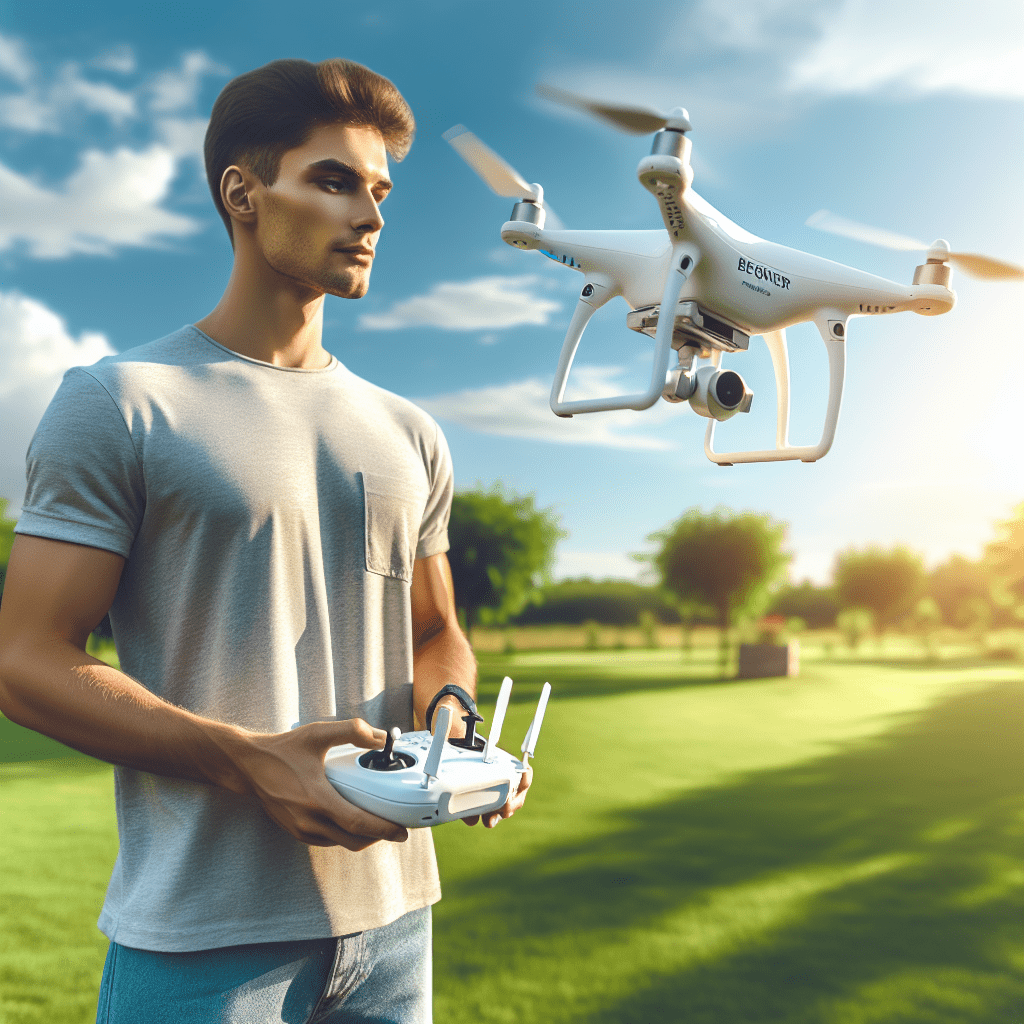Drone Flying Basics: Beginner’s Guide to Confident Flights
In This Article
- Always start with the right beginner-friendly drone equipped with safety features.
- Follow a strict pre-flight checklist before every outing.
- Practice in safe, clear areas and escalate flying challenges gradually.
- Understand and respect all drone regulations in your region.
- Leverage interactive tools and drone apps for continued learning.
Why Every New Drone Pilot Needs a Beginner Guide
Understanding the Basics
Embarking on your journey into the world of unmanned aerial vehicles (UAVs) starts with mastering the fundamentals of Drone Flying Basics. These are not just technical operations; they are essential practices that build the confidence and competence needed to fly responsibly. Without a solid grounding in these principles, it’s easy to cause damage, lose control, or violate local laws. That’s why a comprehensive beginner guide is crucial.
Thanks to their increasing affordability, drones have soared in popularity among hobbyists, photographers, and even commercial operators. However, as with any sophisticated device, they come with a learning curve. Terms like pitch, yaw, throttle, and roll can be confusing at first. The right guidance simplifies these terms and ties them to real-world flying behaviour.
Moreover, understanding the difference between orientation modes, how GPS aids flight stability, and what elements influence battery performance ensures your first flight doesn’t end abruptly or dangerously. This section lays the baseline for anyone eager to fly competently from day one.

Choosing the Right Beginner Drone
What to Look for in Your First Drone
Choosing the right drone is a foundational part of learning Drone Flying Basics. Not all drones are created equal—especially when assessing models designed for beginners. Entry-level drones often feature built-in safety mechanisms, simplified controls, and durable builds that help reduce the consequences of early errors.
Look for models that include altitude hold, headless mode, and one-button takeoff and landing. These features significantly ease the learning process. A drone that returns home automatically can save you from losing your aircraft due to signal loss or misjudged battery life.
Price also plays a vital role. It’s wise to start with a modestly priced yet reputable brand. Well-reviewed beginner drones from companies like DJI, Holy Stone, or Ryze Tech offer reliability without compromising affordability. Remember, the goal is to learn—your first drone is your classroom, not your gear for cinematic videography (yet).
How to Set Up Your Drone
Step-by-Step Setup for First-Time Use
Before you even press the throttle, you’ll need to prepare your drone for operation. This step-by-step setup guide is part of the critical learning within Drone Flying Basics.
Start by charging your batteries fully. Low power can lead to erratic flight or emergency autolanding. Install propellers carefully and check that each is correctly aligned—incorrect installation is a common oversight that leads to wobbling or failure to take off.
Download the companion app if your drone uses one. This will often include calibration functions, live camera view, and GPS settings. Follow the app’s instructions to calibrate the compass and gyros. Most drones will require a flat surface and a rotation process to sync sensors properly.
Finally, pair your remote controller or mobile device with your drone. Conduct a test drive—or more appropriately, a gentle hover—at low altitude to ensure controls respond correctly. Performing a pre-flight check reduces risk and sets you up for a successful flight.
Mastering Drone Controls
Understanding Your Remote
In the heart of Drone Flying Basics lies the effective use of your remote controller. This is your interface with the sky, and mastering it is vital.
Typically, a drone remote features two thumb sticks. The left stick manages altitude (throttle) and rotation (yaw). The right stick controls forward/backward (pitch) and side-to-side (roll) movements. It’s worth dedicating an entire practice session to understanding each input independently. This approach helps you learn how your drone responds under different circumstances.
Many controllers also feature trim buttons to adjust balance, camera angle controls, and customisable buttons for rapid actions like “return home” or “pause”. Read your instruction manual meticulously to understand every switch and function—it ensures you get the most out of your equipment.
Spend time flying in open, obstacle-free areas to refine your sensitivity with the controls. The more instinctive your reactions become, the safer and more enjoyable your flights will be.
Flying Safely: Know the Rules
Drone Laws You Must Know
Knowing the rules is as important as knowing your hardware. One pillar of Drone Flying Basics is understanding legal regulations, which vary by country and sometimes even by region. Flying without knowledge of these can lead to fines, confiscation, or worse.
In the United Kingdom, for example, Civil Aviation Authority (CAA) rules require drones over 250 grams to be registered. Pilots must complete an online theory test to obtain an operator ID. Additionally, your drone must stay below 400ft in altitude and at least 50 metres away from people and private property unless given consent.
Flying inside airport zones or near aircraft requires special permissions. Night flying demands extra caution. Using a drone for commercial work without proper licensing is also prohibited.
It’s your responsibility to keep updated on local drone laws. Use trusted sources like the EASA guidelines on flying drones near people to monitor any changes. Staying informed ensures you’re piloting both legally and responsibly.
“Learning the laws may sound tedious, but it’s the first flight test every responsible pilot must pass.”
Common First-Time Flying Mistakes to Avoid
No matter how excited you are to fly, beginners frequently make errors that can damage their drone or cause safety hazards. One classic mistake is skipping the pre-flight checklist. Forgetting to calibrate your compass or fly with partially charged batteries can create emergencies mid-air.
Another common pitfall is flying in unsuitable weather conditions. Gusty winds or rain can quickly overpower entry-level drones. Also, avoid flying too far from your line of sight. Relying solely on FPV (First-Person View) via your phone or goggles can limit your awareness of surroundings.
Finally, avoid overreaching your skill level in the early days. Don’t try flips, aggressive banking, or proximity flights through tight spaces until you’ve mastered basic manoeuvres. Practice gradually leads to advanced skills without unnecessary crashes or frustration.
Essential Pre-Flight Checklist
Before every flight, perform a structured pre-flight check. This part of Drone Flying Basics is non-negotiable for a safe and predictable flight experience.
- Check that your battery is fully charged.
- Inspect propellers for wear or cracks.
- Confirm firmware is updated via the app.
- Ensure compass and GPS have been calibrated.
- Verify wind and weather conditions are suitable.
- Make sure storage (SD card or cloud) is ready if using the camera.
- Assess for people, trees, and structures nearby.
This quick procedure can prevent most issues and guarantees a smoother flying experience, especially for new pilots.
Practicing Like a Pro
Flying consistently and with purpose is the only way to progress in your drone journey. Follow a progressive practice routine: start with stationary hovering, then slow directional moves, and finally basic patterns like circles and figure eights.
Practise in wide, open fields. This eliminates nearby hazards and builds your confidence. Document your progress with videos to identify weak areas and improvement over time.
Additionally, simulate engine failures or practice emergency landings to prepare for inevitable surprises. The more capable you become at calm recovery, the better your long-term flying skillset.
Upgrading and Advancing Your Drone Skills
Once you’ve internalised the Drone Flying Basics, it’s time to develop professionally. Upgrade to drones with stabilised gimbals, longer flight times, and intelligent flight modes. These additions widen your creative and commercial horizons.
Start exploring manual camera settings, waypoints, and obstacle avoidance systems. Acquire certifications if you intend to fly commercially. Mastering these advanced elements turns hobbyists into pros and ensures your drone fits whatever purpose you envision.
You may also consider joining drone flying clubs or online pilot communities. Platforms like Learn more about Drone Flying & Safety Guides allow learning, sharing and competing while expanding your exposure to new techniques.
Interactive Tools & Drone Training Apps
Technology can radically amplify your learning. Many apps exist to help simulate flight scenarios or fine-tune your skills. Tools such as DroneDeploy, AirMap and DJI Flight Simulator mimic real-world flight physics in a risk-free environment. These platforms assist with understanding airspace restrictions, planning flights, and reviewing flight logs.
Meanwhile, YouTube tutorials, interactive guides like Read a related article, or AR-enhanced maps can bring learnings to life. These resources encourage safe and effective learning while keeping your enthusiasm alive.
Regular engagement with training tools speeds up your development and keeps your flights safer in the long run.
Conclusion & Next Steps
Mastering Drone Flying Basics is more than just learning controls. It’s about forming habits that promote safe, competent flight now and in the future. From selecting the right drone to understanding how to fly within the law, every phase matters—especially for first-timers.
Continue experimenting, observing and refining your technique. Technology evolves quickly, and staying informed is key. Share your experiences in forums, seek mentorship, and never stop flying safely. The sky isn’t just the limit—it’s your playground.
Great guide on how-to-fly-a-drone-for-the-first-time-starter-guide-interactive-instructions-and-tips-for-absolute-beginners-learning-to-fly-a-drone-safely-and-confidently – Community Feedback
How to fly a drone for beginners step by step?
To fly a drone for beginners step by step, use your controller to move forward, backward, left or right, and practice gentle throttle and directional inputs until you feel comfortable.
What is the 1 to 1 rule drone?
The 1:1 rule means always keeping your drone at least as far from people as the height you are flying – e.g., if flying at 40m, stay 40m away from uninvolved persons, never closer than 30m.
What is the 250 gram rule for drones?
Drones over 250 grams must be registered with the FAA. Registration is affordable, valid for 3 years, and ensures legal operation.
Will the FAA know if I fly my drone?
The FAA monitors drone flights in various ways, especially in restricted areas or for unregistered drones, so it’s essential to follow the rules and stay compliant.

